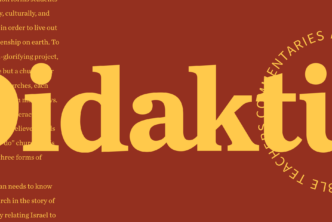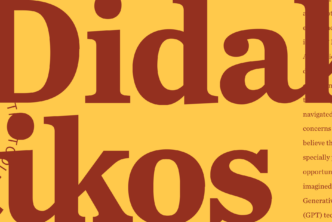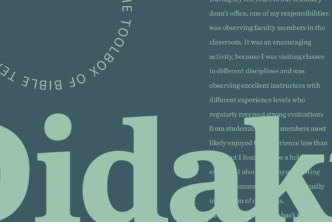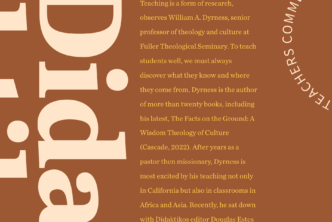Mark S. Gignilliat | Beeson Divinity School
The proverbial mid-life whatever-you-wish-to-call-it exists in one form or another, and the academic is especially vulnerable. The hamster’s wheel of academic life can charm and dull at the same time. In early academic life, the world of teaching and research offers a limitless horizon. The career plane was all take-off and ascent—postgraduate work, land a job, publish or perish, tenure, promotion. All of these moments comingle excitement and anxiety—two of ambition’s more potent stimulants.
At some point, however, the vocation plane levels off and the excitement fades, along with a clear sense of what’s next. Mid-career academics have to face up to certain limitations both in teaching and research. It’s the kind of heavy reality that sets in when walking the stacks of your library. “Here are all of these books, rows upon rows,” goes the thought. “I’ll spend the next three years of my life filling that little slot right there. Breathe in; breathe out.” I used to snicker at these mid-life caricatures, whether in professional or personal guise. I don’t anymore. Truth be told, it’s quite easy to get lost in the woods, becoming a fellow traveler with Dante in his own mid-life moment:
Midway in our life’s journey, I went astray
from the straight road and woke to find myself
alone in a dark wood.1
In the midst of these dark woods, I have found some help along the way. I’m only vaguely familiar with the work of Joseph Pieper, having recently discovered his classic Happiness and Contemplation and Leisure: The Basis of Culture. These two books are life rafts for the mid-career academic, especially the gem on leisure. I should mention a couple of other timely volumes. Adam Neder’s Theology as a Way of Life and Kathleen Norris’s Acedia and Me join company. Neder’s little treasure provides a deeply moving reorientation for the theology professor. Drawing on a theological tradition more familiar to me than Pieper’s, Neder reminds teachers and students alike to keep a clear view of God as both object and subject of our vocation. With Karl Barth, Neder calls us back to a place of wonder as the principle location of our work. After reading Neder, I immediately assigned the book to a class of mine and shot him an email of thanks. Books have a season, and Neder’s bloomed at the right time for me. Norris’s book is a simple must-read for those who face acedia’s temptation (or, for that matter, don’t know what acedia is). If you have faced the struggles of mid-career, my hunch is acedia has either taken residence in your life or makes regular visits.
Pieper’s Leisure: The Basis of Culture tackles acedia’s particular temptation. Acedia resides in the world of sloth, though sloth as acedia and sloth as indolence or idleness need some distinction. Aquinas and Kierkegaard get at the heart of the matter when they associate acedia with “oppressive sorrow” or “despair” or, in Aquinas’s more specific terms, “a certain weariness in work.”22 Here’s the dark side of acedia. It despairs in the face of the good things we have received from God. Aquinas identifies acedia as a breach of the third commandment. Sabbath rest exhales before God and his divine goodness, while acedia grows weary in the face of it.
I think theological academics can agree: our teaching and writing and reading lives are divine goods; they’re gifts. Seen in this light, acedia is especially pernicious, and it lurks in the shadows for many whose theological vocation is the life of the mind. I don’t think I have many close friends in theological education who haven’t faced it in some form or another. One colleague of mine rehearsed for me the day it dawned on him that he was no longer a young, promising scholar. Those kinds of familiar thoughts are acedia knocking at the door.
Well, that’s acedia’s ugly portrait. Cheery, isn’t it? Pieper’s little book on leisure does not airbrush this portrait, but his engagement with acedia serves the larger purpose of reorienting us to the wonders of a life lived before God and his goodness. His books brim with light and energy and hope. “The contrary of acedia,” Pieper clarifies, “is not the spirit of work in the sense of every day, of earning one’s living; it is man’s happy and cheerful affirmation of his own being, his acquiescence in the world and in God—which is to say love.”33 The life of leisure—the privilege of academics—is a life where space is made for celebration of God, the world, and our place in it. What exactly is leisure? In the classical sense of the term, leisure is not the turn toward the back nine or one’s feet nestled in the ocean sand—helpful as these activities are! Leisure is school, and school is the place where one begins to make sense of the world, to listen to the essence of things. In Christian theological education, school marks the place where our minds and affections learn to think and feel after our triune God by means of Scripture and the wide river of the church’s tradition.
Pieper helps us avoid a particular temptation of our moment in time—namely, providing justification for our academic lives in the face of more practical and measurable outcomes. “Is there a sphere of human activity, one might say even of human existence, that does not need to be justified by its inclusion in a five-year plan and its technical organization?”44 An evening out with Joseph Pieper and Max Weber would prove interesting, because Pieper discredits Weber’s “overvaluing of the sphere of work” or the reduction of life to its servile interests.55 Work is important and a great good, but, for Pieper, it is not an end. Work serves leisure, and leisure remains the contemplative and happy life lived before God. When I become one with what I do, then I am removed from the essence of my being. In short, we lose ourselves in this reduction. We can also lose God.
That last paragraph is a hornet’s nest, admittedly, and open to critical scrutiny with a more robust theology of work or a more Reformational understanding of vocation. But I’m not writing about these matters, interesting as they are. I’m writing to mid-career academics or academics who will in time become mid-career academics. Our lives are lives of leisure in the classic sense of the term; we live in school. And what we do is not always practical in the measurable sense of the term. For some, this feature of our leisurely life can be a burden. Shouldn’t I be doing more? Or, does what I do really matter?
Part of my teaching load includes Biblical Hebrew. Every year at some point or another, it’s aleph, beth, gimel, one more time. I have my reasonable doubts about how many of my students will be making good on this investment ten years from now, and from time to time I am seized by the potential futility of the effort. I get it. It’s easy enough to let language learning slide. How many New Testament professors out there would like a pop quiz on the hifil or III-hey verbs? I wouldn’t like one on mi verbs, I know that. My “I can read German” is now, “I can read some German.” So I’m not being fussy about the reality of language learning.
But in the face of this perceived futility, other features of my vocation—even the Hebrew part—become clearer. I’m with real students, people being formed for ministry, and I benefit from the energy they bring to the classroom. We read Scripture together and set out a course for a lifelong love affair with Christ and his word. These moments of the teacher’s vocation have a telos to them, but the atelic moments are what aggregate over time, shaping our being and moving us toward joyful rest in the now. I believe the shift from telic to atelic priorities creates a good bit of the turbulence associated with mid-career and mid-life.66 Once through the turbulence, however, academic life is seen for what it is: a life of grace, a gift. I have an exuberant colleague and friend who often blurts out, “Can you believe we have these jobs?!” Exactly.
“I have never bothered or asked,” Goethe said to Friedrich Soret in 1830, “in what way I was useful to society as a whole; I contented myself with expressing what I recognized as good and true. That has certainly been useful in a wide circle; but that was not the aim; it was the necessary result.”77
Pieper paints with bold and bright colors. His polemic targets what he calls the “proletarianism” taking hold of all levels of society. This malady moves our eyes away from the eternal hills and forces us to limit our existence and activity to the artes serviles. Yet Pieper does not come across ornery in his polemic; he is downright effervescent. What’s the justification for leisure? That’s a big question to ask in the face of modern humanity’s penchant for the servile and measurable. His answer: celebration and worship, living life before the wonder of the divine. Pieper’s celebration of celebration is a cool breeze for the arid academic.
“Divine worship, of its very nature, creates a sphere of real wealth and superfluity, even in the midst of the direst material want—because sacrifice is the living heart of worship. And what does sacrifice mean? It means a voluntary offering freely given.”8 Leisure without worship, warns Pieper, is laziness. Work without worship is inhuman, like poor old Sisyphus laboring up the mountain one more time. Pieper reminds us, “To work is to pray.”
“The work of a Beethoven and the work of a charwoman become spiritual on precisely the same condition, that of being offered to God, of being done humbly ‘as to the Lord,’ ” writes C. S. Lewis.9 When the vocation plane levels off for those of us mid-career academics, temptations await. I realize we are all hard-wired in different ways, but I have my hunch that many out there in the world of theological education know of what I speak. I have enough of Martin Luther’s soteriology in me to know that the truths of the gospel and the gifts of our vocation are not learned and embraced once and for all but must be visited again and again. Pieper’s portrayal of leisure as worship came to me as a kindness, especially during this season where telic modes of being—What am I to do next?—-become tempered by deeper atelic concerns: What kind of person am I? How am I to live into this moment before me? And will the hamster’s wheel be an invitation to acedia or cause for celebration before the God who knows no before and after but only the eternal now?
I may accept this intellectually, but I have to come to appreciate its depths only through experience. Just when I seem to have my life in the balance and imagine I can remain in this happy state forever, I lose sight of the value of contemplation and prayer, and try to live without it. Soon enough, once again, I am picking myself up out of the ashes.10
MARK S. GIGNILLIAT is currently working on Reading the Old Testament as Christian Scripture (coauthored with Heath Thomas; Baker Academic). Later this year, he will begin a commentary on Isaiah for a new series with Eerdmans, Commentaries for Christian Formation. See also his A Brief History of Old Testament Criticism: From Benedict Spinoza to Brevard Childs (Zondervan, 2012)
This article was first published in Didaktikos: Journal of Theological Education. Subscribe for your free subscription today, for all theological faculty, here.

- Dante, Inferno, Canto I.
- Summa Theologica, II.II, Q. 35.1.
- Joseph Pieper, Leisure: The Basis of Culture (San Francisco: Ignatius, 2009), 45.
- Pieper, Leisure, 38.
- Pieper, Leisure, 20.
- On this point, see the helpful work of MIT’s Kieran Setiya, including Midlife: A Philosophical Guide (Princeton: Princeton University Press, 2018).
- Pieper, Leisure, 40.
- Pieper, Leisure, 68.
- C. S. Lewis, “Learning in War-Time,” in The Weight of Glory (New York: Harper One, 2001), 55–56.
- Kathleen Norris, Acedia and Me: A Marriage, Monks, and A Writer’s Life (New York: Riverhead, 2008), 86.





